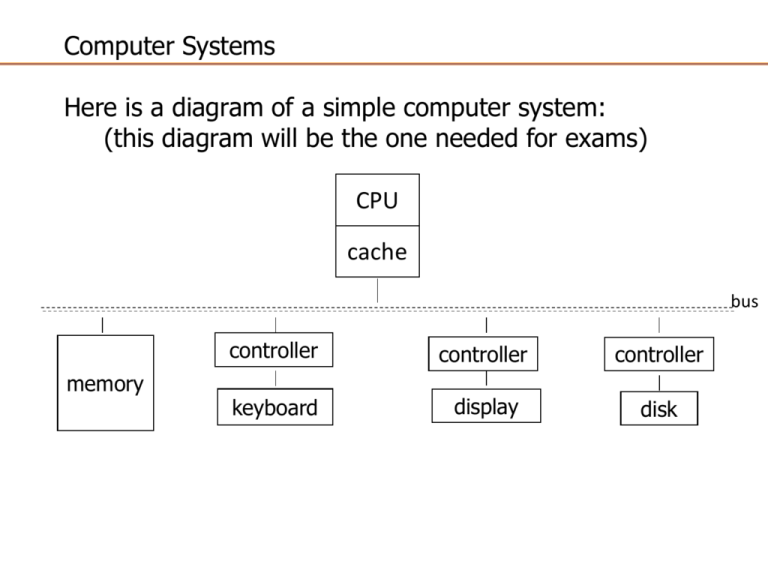Notes
advertisement

Computer Systems Here is a diagram of a simple computer system: (this diagram will be the one needed for exams) CPU cache bus memory controller controller controller keyboard display disk Computer Systems A current consumer PC uses multiple buses (this diagram is *not* required for exams) DRAM memory Backside = CPU L2 cache = core FSB 800 MHz North-Bridge Controller (memory hub) Graphics accelerator AGP (with local memory) monitor 1 Gbit Ethernet disk Serial ATA Parallel ATA CD/DVD 10 Mbit Ethernet PCI bus South-Bridge Controller South-Bridge has dedicated ports for legacy devices, such as Q Mouse keyboard, floppy; also has serial and parallel ports (I/O hub) South-Bridge typically contains flash eprom holding the BIOS, real-time clock, CMOS memory, w\ independent battery backup. Computer components • input - keyboard, mouse, scanner, ... • output - display, printer, sound, ... CPU == central processing unit == processor composed of two parts: • datapath (temporary memory, called registers, and function units) • control logic (sequencing of datapath actions) different instruction sets: Intel IA32 (x86), Apple/IBM/Motorola PowerPC, Sun SPARC, ARM, ... common instructions include add, subtract, jump, ... Computer components (cont’d) memory multilevel hierarchy due to cost vs. speed tradeoffs fastest and most expensive --> CPU registers cache (perhaps multiple levels) main memory slowest and least expensive -> long-term storage cache and main memory are made of RAM - random access memory DRAM - dynamic RAM - most main memories SRAM - static RAM - fast and expensive, used for caches ROM - read-only memory (holds initial "bootstrap“ loader program and basic I/O programs) Computer components (cont’d) long-term storage - so slow that it is treated as I/O floppy disk hard disk CD-ROM DVD Prefixes for speed, time, and capacity 3 10 K (kilo-) = one thousand = 10 ~ 2 6 20 M (mega-) = one million = 10 ~ 2 9 30 G (giga-) = one billion = 10 ~ 2 12 40 T (tera-) = one trillion = 10 ~ 2 15 50 P (peta-) = one quadrillon = 10 ~ 2 18 60 E (exa-) = one quintillion = 10 ~ 2 -3 m (milli-) = 10 -6 u (micro-) = 10 -9 n (nano-) = 10 -12 p (pico-) = 10 -15 f (femto-) = 10 -18 a (atto-) = 10 main memory size is measured in powers of two, while speed is in powers of 10 (the capacity of most hard disks is measured in powers of ten) Prefixes for speed, time, and capacity note that some folks are now using special binary prefixes to prevent any confusion (http://physics.nist.gov/cuu/Units/binary.html) Ki (kibi-) = kilobinary = 210 Mi (mebi-) = megabinary = 220 Gi (gibi-) = gigabinary = 230 Ti (tebi-) = terabinary = 240 Pi (pebi-) = petabinary = 250 Ei (exbi-) = exabinary = 260 Program translation symbolic (i.e., human readable) languages high-level language (HLL) assembly language – one-to-one (approx.) correspondence with machine insts. machine instructions - represented inside the computer in bit (0/1) patterns HLL assembly lang machine code(object file or executable) -----------------------------------------------------------A = B + C; --> load(B) --> 0000 0010 0010 0100 add(C) 0000 0001 0010 0101 store(A) 0000 0011 0010 0011 each moves closer to the bit representation needed by hardware for execution Program translation Compiler – A translator that translates statements written in a high-level language (HLL) into assembly code, performing various optimizations and register allocations along the way. Interpreter – A translator that translates and executes all at a single time Assembler – A program that takes assembly instructions and converts them into machine code that the computer's processor can use to perform its basic operations. The resulting file is called an object file. Program translation Assembly Language • a statement in an assembly language is called an instruction • an instruction is composed of − operation code (opcode) − operands (names of registers and/or information needed to generate a memory address) example: ARM assembler ARM symbolic code -------> main: mov r0, #0x1 mov r1, #0x0 loop: cmp r0, #0x5 beq stop add r1, r0, r1 add r0, r0, #0x1 b loop stop: … address machine code (in hexadecimal) 0x00000000 0x00000004 0xE3A00001 0xE3A01000 0x00000008 0x0000000C 0x00000010 0x00000014 0x00000018 0xE3500005 0x0A000002 0xE0801001 0xE2800001 0xEAFFFFFA Assembly Language • labels (like “loop" in the previous example) represent symbolic addresses of data and branch targets in the program • each label must be unique (i.e., it must be defined only once) assembly symbolic program (human readable) ----------> machine code (binary) symbolic labels memory addresses opcodes bit patterns in instructions operand identification (registers bit patterns in instructions and memory address info) immediate operand values (constants) bit patterns in instructions Assemblers Assemblers have a two-pass structure instructions can have forward or backward references to labels note that a forward reference requires a two-pass assembly structure since you encounter a "use" before its "definition" and thus cannot immediately translate the label into its memory address thus: pass 1 - increment a location counter as you read each assembly language statement and collect any label definitions into a symbol table with the corresponding location counter values pass 2 - translate the assembly language statements using the symbol table Forward References example: the instruction "jmp next" - forward reference to jump target label "next" the instruction "add x" - forward reference to data label "x" pass 1 ----------> symbolic code assign addresses using a location counter ... 100: ... jmp next 101: jmp next ... 102: ... next: add x 103: add x ... 104: ... halt 105: halt x: .word 15 106: 15 pass 2 ----------> translated code (will be represented in binary) ... <jmp op><addr=103> ... <add op><addr=106> ... <halt op> <value=15> _symbol_table_ symbol addr New entry when you encounter a label next 103 x 106 … … Table lookup yielding address when you encounter a symbolic label (note that the symbol table for the assembler holds the address 106 of "x", not its initial value of 15) alternatively, if you keep all the translated code in memory, you can translate in one pass over the input -- but you must keep a record of all unresolved uses of a label (e.g., the symbol table entry for an as-yet-undefined label points to a linked list of all forward references) and then you backtrack and fixup those uses whenever the definition is encountered







